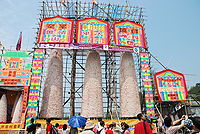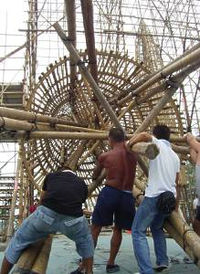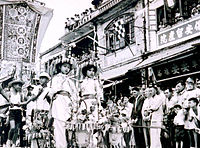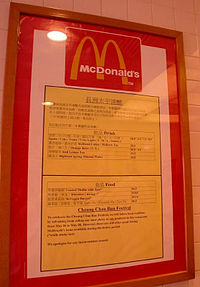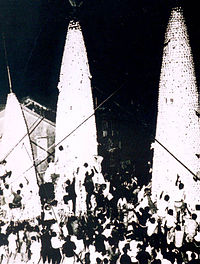- Cheung Chau Bun Festival
-
Cheung Chau Bun Festival (Chinese: 包山節; Jyutping: baau1 saan1 zit3) or Cheung Chau Da Jiu Festival (Chinese: 長洲太平清醮; Jyutping: coeng4 zau1 taai3 ping4 cing1 ziu3) is a traditional Chinese festival on the island of Cheung Chau in Hong Kong. Being held annually, and with therefore the most public exposure, it is by far the most famous of such Da Jiu festivals, with Jiu (醮) being a Taoist sacrificial ceremony. Such events are held by mostly rural communities in Hong Kong, either annually or at a set interval of years ranging all the way up to once every 60 years (i.e. the same year in the Chinese astrological calendar). Other places that may share the folk custom include Taiwan, Sichuan, Fujian and Guangdong.
Contents
Overview
Cheung Chau's Bun Festival, which draws tens of thousands of local and overseas tourists every year, is staged to mark the Eighth day of the Fourth Moon, in the Chinese calendar (this is usually in early May). It coincides with the local celebration of Buddha's Birthday.
The Cheung Chau Bun Festival began as a fun and exciting ritual for fishing communities to pray for safety from pirates. Today this religious origin has largely been forgotten, and the festival has mainly become a showcase of traditional Chinese culture.
History
One story of the origin of the festival is that in the 18th Century the island of Cheung Chau was devastated by a plague and infiltrated by pirates until local fishermen brought an image of the god Pak Tai to the island. Paraded through the village lanes, the deity drove away evil spirits. Villagers also disguised themselves as different deities and walked around the island to drive away the evil spirits.
Activities
Vegetarian
Every year on the 8th day of the fourth month of the lunar calendar, the islanders organise a weeklong thanksgiving, the Cheung Chau Bun Festival usually in April or May. The festival lasts for seven days. On three of these days the entire island[citation needed] goes vegetarian; most of the island's famous seafood restaurants adhere to this tradition. The local McDonald's also takes meat off the menu and instead sells burgers made of mushrooms.
Parade of floats / Parade-in-the-air
In addition to traditional lion dances and dragon dances, children dressed as legendary and modern heroes are suspended above the crowd on the tips of swords and paper fans (飘风). They form the parade-in-the-air and are all secured within steel frames, though they appear to glide through the air. Parents consider it a great honour for their offspring to be part of the parade.
This fascinating procession is accompanied by the bedlam of musicians loudly beating gongs and drums to scare away evil spirits. It is led by a spectacular image of Pak Tai, the God of Water and Spirit of the North, to whom the island's Temple of the Jade Vacuity is dedicated.
Deities
Here are some divinities Cheung Chau people celebrate in the festival:
Pak Tai
Since Cheung Chau is traditionally an island of fisherfolk, Pak Tai is its most revered divinity, since it is believed he has the power to confer smooth sailing for the fishing boats as well as providing good catches for their crews. Pious believers recognise him as "Pei Fang Chen Wu Hsuan T'ien Shang Ti" (True Soldier and Superior Divinity of the Deep Heaven of the North).
Tin Hau
The second of the significant deities whose images add a supplementary splatter of Oriental holiness to the pageant is the much-revered Tin Hau, Goddess of the Seas and protector of all fishermen and boat people. Celebrated for providing warnings of imminent storms and saving countless lives from wreckage, she is in many ways Pak Tai's competitor for the fondness of the fisherfolk.
Kuan Yin and Hung Hsing
Two more gods complete the celestial divinities taking part in the parade: Kuan Yin, the Goddess of Mercy with her tranquil and ever compassionate smile; and Hung Hsing, the terrifying God of the South with his menacing head-dress, unkind face, bushy black beard, and stave at the ready to chastise all enemies.
Bun snatching
 Steamed buns for the "Bun Mountain", being stamped the crimson characters of the respective district (北社, "Northern Society" shown in a combined way) on the island.
Steamed buns for the "Bun Mountain", being stamped the crimson characters of the respective district (北社, "Northern Society" shown in a combined way) on the island.The centrepiece of the festival is at Pak Tai Temple where are the "Bun Mountains" or "Bun Towers"(包山), three giant 60-feet bamboo towers covered with buns. It is those bun-covered towers that give the festival its name. Historically, young men would race up the tower to get hold of the buns; the higher the bun, the better fortune it was supposed to bring to the holder's family; the race was known as "Bun-snatching" (搶包山).[1] However, during a race in 1978 one of the towers collapsed, injuring more than 100 people. In subsequent years, three designated climbers (one climber to each tower) raced up their respective towers and having cleared the top buns proceeded to strip the towers of their buns as they descended.
The three "Bun Mountains" are still placed in the area in front of Pak Tai Temple, and are constructed using the traditional fixation method -- bamboo scaffolding.
In 2005, a single tower climbing event in the adjacent sports ground was revived as a race -- with extra safety precautions including proper mountain-climbing tools as well as tutorials for participants (which now include women). A teamwork version of the event was added in 2006.The revised version of "Bun-snatching" as well as the traditional three "Bun Mountains" still have their buns removed from the towers at midnight of the Festival.
In February 2007, it was further announced that the buns on the single-tower construct will henceforth be made of plastic.[2] During the festival, Chinese operas, lion dances, and religious services also take place on the island.
Burning of paper effigies
At a quarter to midnight a paper effigy of the King of the Ghosts is set ablaze, enormous incense sticks are lit and the buns are harvested and distributed to the villagers, who, pleased to be sharing in this propitious good fortune, rejoice late into the night.
Return of bun-snatching
As aforementioned, the bun-snatching ritual was abandoned by the government due to the 1978 collapse. Still, a large portion of Cheung Chau villagers regard this as part and parcel of their daily life, and the precious culture of Hong Kong to boot. In addition to the villagers' immense urge to resume the ritual, a local cartoon movie My life as McDull recalled the forlorn ceremony, giving a tinge of nostalgia to its audience. As such, the long-awaited ritual was reintroduced on 15 May 2005. Safety measures were intensified: only 12 well-trained athletes selected from preliminary competitions were permitted to climb on one single "Bun Mountain"; instead of bamboo, the framework of the "Bun Mountains" was made up of steel.
More about My life as McDull and bun-snatching
My life as McDull was a sizable hit in Christmas 2001. This Hong Kong animated feature was primarily targeted at children. Aside from the cute character designs, however, My Life as McDull had also shown many renowned qualities of Hong Kong people — hard-working, carefree, and never giving up. The "Hong Kong dream" depicted in the film has charmed much of its audience. The animation is aided by computer-generated backgrounds, but it retains a delightful hand-drawn look that is pleasing to the movie-goers. In a part of the film, McDull decides to train to be an Olympic-level athlete like Hong Kong Olympian Lee Lai-shan. However, the trade he learns is Cheung Chau bun-snatching. Realising that bun-snatching is not a formal sporting event in the Olympic games, McDull’s mother writes a letter to the chairman of International Olympic Committee (IOC) to ask him/her to sanctify the so-called sports event with her limited proficiency of English.
Some people[who?] think that the Hong Kong Tourism Board began to promote the forlorn ritual thanks to the unanticipated box-office success. It spawned a laughing stock, though, when the Secretary for Home Affair, Patrick Ho Chi-ping, said he might contact IOC later on in order to formalise the "sports". He even told to the public that the bun-snatching ceremony can be varied into many other events, like cake-snatching ceremony, doll-snatching ceremony, etc..[citation needed]
See also
- Culture of Hong Kong
- Chinese mythology
- Taipingqingjiao
References
- ^ TVB show 1st quarter of 2008: 賞識人間道, exclusive on the bun race.
- ^ HK government: Bun Festival upholding both tradition and safety
External links
Categories:- Cheung Chau
- Festivals in Hong Kong
- Buddhist holidays
- Buddhist festivals
Wikimedia Foundation. 2010.

